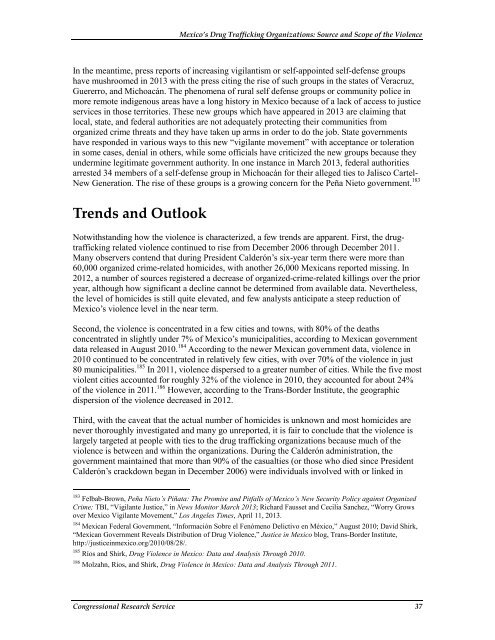Mexico's Drug Trafficking Organizations - Federation of American ...
Mexico's Drug Trafficking Organizations - Federation of American ...
Mexico's Drug Trafficking Organizations - Federation of American ...
Create successful ePaper yourself
Turn your PDF publications into a flip-book with our unique Google optimized e-Paper software.
Mexico’s <strong>Drug</strong> <strong>Trafficking</strong> <strong>Organizations</strong>: Source and Scope <strong>of</strong> the Violence<br />
In the meantime, press reports <strong>of</strong> increasing vigilantism or self-appointed self-defense groups<br />
have mushroomed in 2013 with the press citing the rise <strong>of</strong> such groups in the states <strong>of</strong> Veracruz,<br />
Guererro, and Michoacán. The phenomena <strong>of</strong> rural self defense groups or community police in<br />
more remote indigenous areas have a long history in Mexico because <strong>of</strong> a lack <strong>of</strong> access to justice<br />
services in those territories. These new groups which have appeared in 2013 are claiming that<br />
local, state, and federal authorities are not adequately protecting their communities from<br />
organized crime threats and they have taken up arms in order to do the job. State governments<br />
have responded in various ways to this new “vigilante movement” with acceptance or toleration<br />
in some cases, denial in others, while some <strong>of</strong>ficials have criticized the new groups because they<br />
undermine legitimate government authority. In one instance in March 2013, federal authorities<br />
arrested 34 members <strong>of</strong> a self-defense group in Michoacán for their alleged ties to Jalisco Cartel-<br />
New Generation. The rise <strong>of</strong> these groups is a growing concern for the Peña Nieto government. 183<br />
Trends and Outlook<br />
Notwithstanding how the violence is characterized, a few trends are apparent. First, the drugtrafficking<br />
related violence continued to rise from December 2006 through December 2011.<br />
Many observers contend that during President Calderón’s six-year term there were more than<br />
60,000 organized crime-related homicides, with another 26,000 Mexicans reported missing. In<br />
2012, a number <strong>of</strong> sources registered a decrease <strong>of</strong> organized-crime-related killings over the prior<br />
year, although how significant a decline cannot be determined from available data. Nevertheless,<br />
the level <strong>of</strong> homicides is still quite elevated, and few analysts anticipate a steep reduction <strong>of</strong><br />
Mexico’s violence level in the near term.<br />
Second, the violence is concentrated in a few cities and towns, with 80% <strong>of</strong> the deaths<br />
concentrated in slightly under 7% <strong>of</strong> Mexico’s municipalities, according to Mexican government<br />
data released in August 2010. 184 According to the newer Mexican government data, violence in<br />
2010 continued to be concentrated in relatively few cities, with over 70% <strong>of</strong> the violence in just<br />
80 municipalities. 185 In 2011, violence dispersed to a greater number <strong>of</strong> cities. While the five most<br />
violent cities accounted for roughly 32% <strong>of</strong> the violence in 2010, they accounted for about 24%<br />
<strong>of</strong> the violence in 2011. 186 However, according to the Trans-Border Institute, the geographic<br />
dispersion <strong>of</strong> the violence decreased in 2012.<br />
Third, with the caveat that the actual number <strong>of</strong> homicides is unknown and most homicides are<br />
never thoroughly investigated and many go unreported, it is fair to conclude that the violence is<br />
largely targeted at people with ties to the drug trafficking organizations because much <strong>of</strong> the<br />
violence is between and within the organizations. During the Calderón administration, the<br />
government maintained that more than 90% <strong>of</strong> the casualties (or those who died since President<br />
Calderón’s crackdown began in December 2006) were individuals involved with or linked in<br />
183 Felbab-Brown, Peña Nieto’s Piñata: The Promise and Pitfalls <strong>of</strong> Mexico’s New Security Policy against Organized<br />
Crime; TBI, “Vigilante Justice,” in News Monitor March 2013; Richard Fausset and Cecilia Sanchez, “Worry Grows<br />
over Mexico Vigilante Movement,” Los Angeles Times, April 11, 2013.<br />
184 Mexican Federal Government, “Información Sobre el Fenómeno Delictivo en México,” August 2010; David Shirk,<br />
“Mexican Government Reveals Distribution <strong>of</strong> <strong>Drug</strong> Violence,” Justice in Mexico blog, Trans-Border Institute,<br />
http://justiceinmexico.org/2010/08/28/.<br />
185 Ríos and Shirk, <strong>Drug</strong> Violence in Mexico: Data and Analysis Through 2010.<br />
186 Molzahn, Rios, and Shirk, <strong>Drug</strong> Violence in Mexico: Data and Analysis Through 2011.<br />
Congressional Research Service 37















